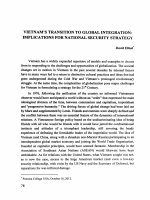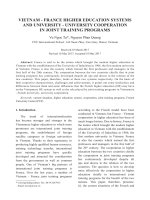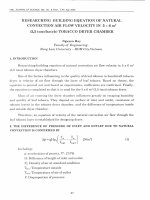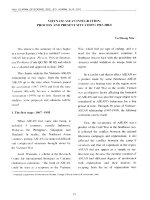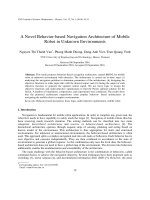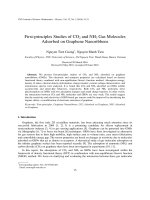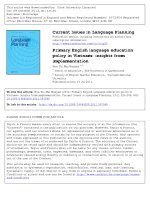DSpace at VNU: Vietnam - France higher education systems and university - university cooperation in joint training programs
Bạn đang xem bản rút gọn của tài liệu. Xem và tải ngay bản đầy đủ của tài liệu tại đây (292.18 KB, 13 trang )
VIETNAM - FRANCE HIGHER EDUCATION SYSTEMS
AND UNIVERSITY - UNIVERSITY COOPERATION
IN JOINT TRAINING PROGRAMS
Vu Ngoc Tu*, Nguyen Phan Quang
VNU International School, 144 Xuan Thuy, Cau Giay, Hanoi, Vietnam
Received 10 March 2017
Revised 16 May 2017; Accepted 18 May 2017
Abstract: France is said to be the nation which brought the modern higher education to
Vietnam with the establishment of the University of Indochina in 1906, the first modern university
in Vietnam. France is also the country which trained the first professors and managers in the
first half of the 20th century. The cooperation between the two countries chiefly that in joint
training programs has continuously developed despite all ups and downs in the relation of the
two countries. This paper, therefore, looks at these two systems respectively. On the basis of
their respective characteristics, challenges and achievements, it points out some similarities and
differences between them and some influences that the French higher education (HE) may have
on the Vietnamese HE system as well as the role played by joint training programs in Vietnamese
- French university- university cooperation.
Keywords: current situation, higher education system, cooperation, joint training programs, French
University Center (PUF)
1. Introduction
The trend of internationalization
has become stronger and stronger in the
Vietnamese higher education in which more
prominent are international joint training
programs, the establishment of foreign
satellite campuses or foreign universities
in Vietnam. Thanks to their supremacy in
producing highly qualified human resources,
training technology transfer, international
joint training programs have quickly
developed and attracted the consideration
from the government as well as common
people. One of Vietnam’s big partners of
international joint training programs is
France. Over the last years, a number of
Vietnam - France joint training programs
* Corresponding author. Tel.: 84-913247915
Email:
according to the French model have been
conducted in Vietnam, but France - Vietnam
cooperation in higher education has been of
much longer history. Due to history, France is
the nation which brought the modern higher
education to Vietnam with the establishment
of the University of Indochina in 1906, the
first modern university in Vietnam. France
is also the country which trained the first
professors and managers in the first half of
the 20th century. The cooperation in higher
education between the two countries chiefly
the cooperation in joint training programs
has continuously developed despite all
ups and downs in the relation of the two
countries. The question is how to develop
more effectively the cooperation in higher
education chiefly in international joint
training programs for the benefit of the two
nations. This paper, therefore, presents:
(i). the current situations of the French and
134
V.N. Tu, N.P. Quang / VNU Journal of Foreign Studies, Vol.33, No.3 (2017) 133-145
Vietnamese higher education respectively,
(ii). French education in Vietnam, (iii).
university - university cooperation in joint
training programs and then points out some
suggestions and recommendations for further
cooperation.
2. French higher education system
2.1. Current situation
French higher education system awards
the following degrees recognized by the
Bologna Process: Bachelor’s degree (3
years), Master’s (2 years), and doctorate
(3 years). French universities have also
adopted the ECTS credit system (for
example, a Bachelor’s degree is composed
of 180 credits). However, the traditional
curriculum based on the end of semester
examinations still remains in place in most
universities. This double standard has added
complexity to a system which also remains
quite rigid. It is difficult to change a major
during undergraduate studies without losing
a semester or even a whole year. Students
usually have few course selection options
once they enroll in a particular diploma . In
other words, France has a complicated system
of higher education. However, it might
be right to say that the French HE system
consists of two main types of institutions: (i).
universities and (ii). Grandes Ecoles.
(i). Universities: France has 82 state
universities, five Catholic universities and
a number of private institutes, which are
under the theoretical control of the local
education authority, and are run by a board
presided over by an elected president. The
presidents of universities are elected by the
board for a period of 4 years and can hold the
position for two terms. The board consists of
elected representatives of the teaching staff
(about 50% of members), of administrative
staff and students, plus external members
representing local interests .
It should be noted that French universities
are in the process of reorganizing themselves
into massive local federations of existing
universities and institutes of higher education,
known as higher education and research
centers with an aim to save money, by merging
some of the administrative structures currently
duplicated in each university or institution and
to make French universities more “visible” on
the international stage so as boost the ranking
of French universities in international higher
education community.
- Catholic universities offer the same range of
degree courses as state universities, and students
can freely move between the two systems.
- Private universities and other private
institutions: It seems that there are no private
universities except the Catholic ones. There
are other private institutions – schools which
include some of the grandes écoles and a great
number of private establishments offering
business degrees, technical qualifications and
other courses. To offer a degree, a school must
have its courses recognized by the Ministry, in
the same way as public universities .
French universities are ranked among the
most efficient institutions of higher education
in any developed countries in terms of the
ratio between investment per student, quality
and the results obtained although they are
considerably underfunded.
(ii). Grandes Ecoles are higher education
institutions which focus on a single subject
area, such as engineering or business, have a
moderate size, and are often quite selective in
their admission of students. They provide a
cosseted higher education to the nation’s future
elites, leaders of industry, top military brass,
top politicians, engineers, physicists and others.
Grandes Ecoles are very well funded, have small
classes and top teaching staff and some of them
are very famous all over the world
VNU Journal of Foreign Studies, Vol.33, No.3 (2017) 133-145
2.2. French higher education’s superior
characteristics
Nguyen Trong Do (2011) is right to say
that the French higher education has three
main superior characteristics as follows:
(i). Democratic: The history of the
French education is said to be the history of
democratizing higher education. Thanks to the
reforms in the two decades 1980 – 1990, French
universities have become even more democratic
through the students’ participation and role in
the process of university management.
(ii).
Enlightening:
Being
greatly
influenced by churches, French universities
have gradually become institutions of
enlightening, playing an extremely important
role in the social progress. The respect for
truth, teacher – students relation, academic
freedom, relative independence from the state
have become great traditions of the French
higher education. They are the very important
conditions for formulating up a contingent of
intellectuals that France can be proud of.
(iii). Public good: Up till now, most
French universities are public universities. It
is based on the value or belief that considers
education as activities of public good,
different from market values. It is well known
that after the students’ movement in May,
1968 all French universities are open to all
“bacheliers” – those who have passed their
“baccalaureats” (except scientific and medical
training programs). Since higher education
is funded by the state, the fees are low; the
tuition ranges from 150 Euros/year to 700
Euros/year depending on the university and
the different levels of education: Bachelor,
Master, and Doctorate respectively .
It is commonly stated that low expenses have
ensured the equity of education for everyone, and
thus making French universities more attractive
for foreign students. That is exemplified by the
135
number of foreign students in French universities:
over 263,000 in 2006 occupying 11.7%, ranking
as 4th country after America and Australia in
attracting foreign students.
2.3. French higher education’s achievements
Being an old system, the French higher
education is one of the HE systems that
has recorded greatest achievements in
the world. These achievements can be
illustrated by its quantity (the number of
universities, students, teaching staff, training
scope and modern infrastructure…) and
quality
(excellent
professors/scientists/
Nobel Laureates, achievements in science,
technology, engineering, culture and art…). In
the age of globalization, French universities’
achievements have had a profound international
influence (Nguyen Van Do, 1996).
(i). In terms of quantity, it can be said that
France is one of the countries that has the
biggest and most developed higher education.
At present, French universities and higher
institutions accept hundred thousands of
students a year not only from France but also
from hundreds of foreign countries. These
figures have unceasingly increased over
the years. For example, in 1950 the number
of students was only 136,744 compared
to 2,338,100 in 2017, and also in 1950, the
teaching staff was just 5,799 in comparison
with 91,000 in 2017. That is of special
significance because France is a country that
has the oldest population in Europe (Nguyen
Van Do, 1996).
(i). In terms of quality, the French higher
education has produced hundreds of leading
scientists in the fields of sciences, art,
politics, economics, among whom dozens
are great men of the humankind. In the 20th
century, this higher education produced
57 Nobel Laureates, not to mention those
French of other origins or those who were
136
V.N. Tu, N.P. Quang / VNU Journal of Foreign Studies, Vol.33, No.3 (2017) 133-145
trained in France and a number of Fields
winners . Prof. Ngo Bao Chau bearing both
Vietnamese and French nationalities who
received the Fields award was also trained
and then worked in France.
In the field of social sciences, one cannot
help but mention a series of theories, doctrines
and trends of thoughts originating from
France with excellent representatives like
Rousseau, Jean-Paul Sartres, Derrida, but first
and foremost, one should mention Descartes
with his rationalism – the origin of Western
education.
The high quality of the French higher
education is also partially reflected in the
university ranking table in 2017 including:
Ecole Normale Superieur, Paris (66), Ecole
Polytechnique (116), University Pierre et Marie
Curie (121), University of Paris Sud (179) and
Ecole Normal Superieure de Lyon (201)....
2.4. Challenges for French higher education
Nguyen Trong Do, et.al (ibid) holds
that the French higher education is facing
big challenges relating to educational
methodology, finance and management, and
international competition.
(i). Educational methodology:
Relating to the French educational
philosophy of enlightenment, students are
trained to discover the general, fundamental
knowledge. This methodology focuses
on communication rather than criticism,
considering theory more important than
practice. In this modern world, the American
methodology focusing on practice seems to
be more appropriate as it produces human
resources that can easily meet the requirements
of the labor markets.
(ii). Finance and management:
The literature shows that French
universities are not highly competitive as
other universities in other countries. Due
to very low tuitions, French universities are
always struggling with the financial shortage
thus leading to backward physical facilities.
The French education is now facing the
dilemma problem: pressure from the market
mechanism, first and foremost, whether to
impose higher tuition fees so as to upgrade
physical facilities and improve quality or to
maintain the existing mechanism to ensure the
equity of education.
The French HE management has not been
considerably changed since 1968. Mrs.Valerie
Pecresse, French Minister of Higher Education
also emphasized the autonomy of each university.
The management staff of each university should
reduce from 60 to 20-30 people. The university
presidents should be entitled to spend money in
their way including high pays so as to attract or
to keep excellent professors.
(iii). Internationalization:
In order to integrate into the European and
world HE community, France has to reform its
universities. Together with applying Bologna
Process (L-M-D), French universities have to
change their programs in such a way that their
credits can be easily transferred and accepted
in other countries in the world.
It goes without saying that over the last
decades, globalization has become the main
trend of the humankind and the English
language has become more predominant. In
reality, English has become lingua franca
of the Internet age and it is even truer in
the field of higher education. Today, most
scientific
conferences/workshops
are
conducted in English; scientific works
are also published in English. In addition,
in countries like Korea, the percentage of
training programs conducted in English
is considered as an important factor for
receiving financial support from the
government. The predominance of English
also means the decrease of the role of the
VNU Journal of Foreign Studies, Vol.33, No.3 (2017) 133-145
French language. Nowadays, even some
training programs of French universities are
conducted in English. Accepting this reality
means that the French higher education
has to accept the competition with a lot
of disadvantages: French professors have
to be good at English so that they can
teach international programs and have
their research results published in English
journals.
What is more, complying with the
Bologna Process, accepting the ECTS
system and at the same time keeping the
traditional curriculum based on end of
semester examinations have made the French
higher education even more complicated and
to some extent, even more difficult for its
internationalization.
In short, the French higher education is of
an age-old tradition and famous for its quality.
That is a higher education of enlightening,
full of humanistic characteristics. It has
produced a lot of great men and thus has
played an important role in the world higher
education community. Although it may have
some challenges to overcome, they are not
as serious as those the Vietnamese higher
education has to face.
3. Vietnamese higher education system
3.1. Current situation
The Vietnamese HE system certainly has
some differences with the French HE system
in terms of its history of development, its high
quality and diversity as well as its attractiveness
to foreign students. Unlike the French higher
education, the modern Vietnamese higher
education came into being much later than the
French higher education and it was the result
of the West – East cultural exchange, chiefly
under the French domination. The modern
137
Vietnamese higher education first appeared
with the establishment of the University of
Indochina by the French in 1906. Since then,
the Vietnamese HE system has seen a lot of
changes for further development. At present, the
number of HE institutions has increased and the
training quality has gradually improved. From a
system consisting of only narrowly specialized
universities with only Bachelor and Ph.D
degrees following the former Soviet model,
now it has a number of multi-disciplinary/
comprehensive universities offering Associate,
Bachelor, Master and PhD programs.
The Vietnamese HE system consists of
the following 7 types of universities not to
mention colleges and continuing education
schools/institutions:
(i). Specialized universities each of which
focuses on a certain single area of study,
such as economics, banking, law, technology,
agriculture, forestry, fishery …;
(ii). Multi-disciplinary (comprehensive)
universities including three newly established
regional universities in some of Vietnam’s
largest cities;
(iii). National universities, one in Hanoi
established in 1993 and one in Ho Chi Minh
City established in 1995;
(iv). Regional universities: Hue, Da Nang
and Thai Nguyen;
(v). Open universities: two open
universities established in 1994, one in Hanoi
and one in Ho Chi Minh City;
(vi). Foreign universities and;
(vii). Vietnamese – foreign universities.
At present, there are 644 higher education
institutions out of which about 100 are nonpublic in comparison with 376 in 2009 .
Vietnamese higher education is organized
into public and non-public (people-founded/
private). Public institutions receive funding
for infrastructure, facilities and operational
expenditures. Private institutions are funded
138
V.N. Tu, N.P. Quang / VNU Journal of Foreign Studies, Vol.33, No.3 (2017) 133-145
by social, professional, and economic
organizations or individuals for infrastructure,
facilities and operational expenditures. The
government supports public institutions to
ensure that they always play the key role in the
national education system. In addition, there
are institutions with foreign invested capital:
(i). 100% foreign invested institutions and (ii)
joint venture institutions (Higher Education
Law, 2012).
Colleges normally offer three-year
programs and award Associate diplomas to
those who graduate. About two-thirds of
Vietnam’s colleges specialize in training
teachers for lower levels of the education
system. Colleges are small and the students in
these colleges make up a small part of the total
enrolled in public higher education.
In terms of management, it is worth
noting that universities and colleges are not
only managed by the Ministry of Education
and Training (MOET) but also by various
ministries and provincial people’s committees:
by MOET (over 100/644, by other ministries
such as the Ministry of Public Security (11
universities/academies/colleges), the Ministry
of Defence (25) and by provincial people’s
committees. At present, 40/63 provinces
and cities have universities accounting for
65%, 60/63 provinces have colleges making
up 95%. Most of Vietnam’s college-level
institutions are managed by provincial
people’s committees (Nguyen Van Nha & Vu
Ngoc Tu, 2015).
Unlike the French HE system, the
Vietnamese HE system does not have “grandes
écoles”. Vietnamese universities are also run by
a board presided by a president, but the board
consists of representatives of all academic
departments and some representatives of some
functional departments; no representative
of students. The presidents are appointed by
the minister of the Ministry of Education and
Training except that the presidents and vice
presidents of the two national universities
who are appointed by the Prime Minister.
3.2.
Vietnamese
achievements
higher
education’s
Vietnamese higher education over
the last decades has achieved encouraging
results. According to MOET, over 20 years of
reform, it has remarkably developed its scope,
diversified university types and training
modes; begun to adjust the structure of the
system, improved training programs and
training process; mobilized more resources
from the society. The quality of some training
areas has been gradually enhanced. The
HE system has produced qualified human
resources to meet the requirements of the socioeconomic development and industrialization
and modernization of the country, to ensure
national security and defence and speed
up the process of international integration.
University and college management has also
been improved. More importantly, it has
narrowed the gap between Vietnamese higher
education and world HE community and has
confirmed its further development.
The establishment of the two national
universities, three regional universities,
some Vietnamese - foreign universities and
several 100% foreign-owned universities
is also considered as an encouraging result
of the higher education reform. The idea
behind all this is to build a higher education
that is multi-tiered and that includes higher
education institutions operating under different
ownership models (public, private and mixed).
These universities are said to be Vietnam’s first
research-oriented universities which are more
autonomous than other Vietnamese universities
and they are the first universities to hire
administrators and 50-80% foreign lecturers.
However, as higher education is one of the three
VNU Journal of Foreign Studies, Vol.33, No.3 (2017) 133-145
key areas (renovation in mechanism and policy
and renovation in administration and building
a strong and transparent State machinery)
in which to create a breakthrough to change
the socio-economic situation and vigorously
develop human resources, the Vietnamese HE
reform must continue to be carried forward
(Vu Ngoc Tu, 2012).
3.3. Challenges facing Vietnamese higher
education reform
Although the Vietnamese higher education
has recorded encouraging results over the
last decades, it has to be still continued to be
reformed as “without urgent and fundamental
reform to higher education system, Vietnam will
fail to achieve its enormous potential” and there
is a “close relationship between development
and higher education” (Vallely, 2008).
There are more challenges that face the
Vietnamese higher education compared to
those that face the French higher education.
Hayden (2005), MOET’s World Bank
consultant, groups these challenges into
four categories: finance, management
(governance), quality and equity of access.
However, there are other challenges that
should be mentioned. Vu Ngoc Tu (2004), and
Nguyen Van Nha & Vu Ngoc Tu (2015) point
out 10 main challenges as follows:
(i). The biggest challenge is to ensure that
the system of education and training responds
to the emerging demands of a growing
economy, that is, to satisfy the requirements
for human resources of the country’s
industrialization and modernization and
people’s learning requirements. Moreover, the
training scope has not yet met the requirements
of industrialization and modernization; there
is imbalance between supply and demand;
(ii). Inappropriate structure of the higher
education system is manifested by separating
the network of higher education institutions
139
from research academies thus reducing
investment efficiency and the quality of
training and research. Moreover, research is
not paid due attention to, teaching is not yet
closely linked with research and services for
social life;
(iii). Financial resources are limited,
mainly relying on the State budget. In
addition, the centrally determined structure of
funding proves to be inefficient and counterproductive. Most of the HE institutions
in Vietnam are inactive in finding other
financial resources. Hayden (2005) states
that the level of funding for Vietnam’s higher
education is small: only 0.41% of GDP in
2002 out of a total of 4.22% for all levels of
education. In terms of expenditure on higher
education, Vietnam compares poorly to the
rest of the region and the rest of the world
(average is 1.22%);
(iv). Training quality, content and methods
should be improved as training quality and
efficiency are still low. That is confirmed by
Vallely (2008) who states that Vietnam does
not have even a single university of recognized
quality. Learning is not closely combined
with practice, and therefore, human resources
produced are not highly qualified. Training
programs are inflexible focusing on theory
rather than practice and slow in integration;
learning and teaching methods are outdated,
the training process is closed and inflexible. In
general, HE institutions have limited research
capacity; faculty qualifications are generally
low and vary significantly across types of
institutions and regions. Although Vietnam’s
HE system has recently introduced internal
quality measures, it still lacks external quality
measures. Teaching methods are backward, the
level of articulation and global integration is
low. The progress of renovation is slow because
of the slow-changing mindset of teachers and
their heavy teaching load (World Bank, 2007);
140
V.N. Tu, N.P. Quang / VNU Journal of Foreign Studies, Vol.33, No.3 (2017) 133-145
(v). Teaching and administrative staff have
not yet been able to meet the requirements of
HE reform both in terms of quality and quantity.
At present, there are only 77,000 HE teachers/
lecturers out of which only 9,126 have Ph.D.
degrees and 36,347 have Master degrees; and
300,000 management personnel for the whole
education system from general education to
higher education (MOET, August 2012). There
is a serious lack of research experts, and HE
policy makers. Moreover, many lecturers do
not pay due attention to research;
(vi). Management is characterized by
a very high level of centralization. MOET
has significant power over higher education
and determines matters as varied as student
enrolment, academic assessment, budget
decisions, and infrastructure and facility
maintenance. There is a severe lack of close
links between higher education institutions
and scientific research, businesses, industries
and employers. The existing mechanism
and policies have not yet created selfaccountability, responsibility of HE institutions
for personnel, revenue-expenditure balance,
and quality of training products;
(vii). Competition is not created for HE
development. HE institutions’ development
plans are not clear, just short-term rather
than long-.term and HE institutions are not
rationally distributed over the whole country
thus reducing investment efficiency;
(viii). Higher education reform has
not been able to keep pace with economic
reform and requirements for integration;
HE management cannot keep pace with HE
socialization;
(ix). Vietnam higher education has always
affirmed the equity of access very much in
line with “admission to higher education
should be based on the merit, capacity, efforts,
perseverance and devotion and can take place
in a lifelong scheme, at any time, with due
recognition of previous acquired skills”
(UNESCO, 1998). However, at present,
certain groups (women, ethnic minorities,
the less privileged, those from particular
regional areas) are not represented in higher
education proportionately to their numbers
in the population. The reason for this is that
poverty in Vietnam has a geographical aspect,
the poorer regions tend to have fewer HE
institutions, and people just cannot pay for
their higher education and this consequently
results in a lower level of enrolment.
(x). Curricula “as the bulk of Vietnamese
curricula do not meet the needs of about 60%
young laborers who graduate from training
establishments need to be retrained for at least
6-12 months after being recruited” (Nuffic
Neso/Vietnam).
(xi). International competition: Vietnam’s
open door policy has made the Vietnamese
higher education an integral part of the
world HE community thus leading to the
competition between Vietnamese and foreign
universities not to mention foreign universities
in Vietnam. According to recent statistics of
Vietnam Ministry of Education and Training,
the number of Vietnamese students studying
overseas has been increasing to over 60,000.
Although there are many challenges
that face the Vietnamese higher education
reform, they have to be surpassed. Only by
successfully overcoming those challenges,
can the Vietnamese higher education achieve
its main objective: to produce highly qualified
human resources for Vietnam’s socioeconomic development.
As has been pointed out in the previous
sections, there are some differences and
similarities between the Vietnamese and
French HE systems which can be summarized
in Table 1.
141
VNU Journal of Foreign Studies, Vol.33, No.3 (2017) 133-145
Table 1. Similarities and differences between Vietnamese and French higher education systems
Comparison
Vietnamese HE
French HE
Mainly relying on State budget
Low
High level of concentration
Mainly relying on State budget
Low
High level of concentration
Theory more important than practice
Theory more important than practice
Still being planned
Planned and developed
Without churches’ influences
Mostly influenced by churches
Similarities
Budget
Competition
Management
Educational
methodology
Differences
System
Structure
Universities
Staff
Training and research
quality
Curricula/training
contents
Teaching/learning
method
Equity of access
Entrance to university
Tradition/history
Attractiveness to
foreign students
Inappropriate
Appropriate
All comprehensive except Grandes
Many narrowly specialized
Ecole
Teaching and administrative staff: poor Teaching and administrative staff: high
quality
quality
Poor
High (many Nobel Laureates)
Inappropriate
Appropriate and modern
Backward
Modern
Guaranteed
Highly competitive
Short
Not guaranteed
Open to all
Age-old
Little
Much
4. French higher education in Vietnam
4.1. French – Vietnamese higher education
After occupying Vietnam, the French faced
with the greatest difficulty in the language
barrier. To overcome this difficulty, the French
set up an institution to train interpreters
and that was considered as the first French
vocational school/institution in Vietnam.
Along with training interpreters, the French
government opened some more training areas
in administration, justice and finance.
The French – Vietnamese higher
education (Enseignement Franco- Indigene)
was introduced to Vietnam with some
modifications and adjustments of the French
training mechanism and organization to suit the
Indochinese conditions. It consisted of two types
of institutions: (i). Ecole Superieure – vocational
schools/institutions and (ii). universities.
In early 20th century, the French –
Vietnamese higher education became more
stable with the French government’s permission
to open more vocational institutions like
Medicine – Pharmacy, Pedagogy, Law… All
these schools/institutions were in Hanoi and
belonged to the University of Indochina. The
University of Indochina at that time consisted
of School of Indochinese Medicine, School of
Public Administration, School of Indochinese
Veterinary, School of Law and Administration,
School of Pedagogy, School of Agriculture and
142
V.N. Tu, N.P. Quang / VNU Journal of Foreign Studies, Vol.33, No.3 (2017) 133-145
Forestry, School of Indochinese Commerce,
School of Letters (it then merged with the School
of Law and Administration), School of Applied
Science, School of Indochinese Art. The training
programs lasted for 3 years but from 1926 they
changed to 5 years. After that, more programs
were formulated: Architecture, Lacquer Painting
and Ciselure (Nguyen Van Do, 1996).
In short, we can say that the French higher
education system still has had some influences on
the Vietnamese HE system. However, there are
a number of differences between the two higher
education systems. One striking difference student recruitment - should be re-emphasized.
While French universities are open to all high
school students – those who have passed
their “baccalaureat”, except the scientific and
medical programs, the entrance to Vietnamese
universities can be highly competitive (Table 1).
4.2. French higher education in Vietnam at
present
As was mentioned earlier, in the context
that higher education has become a market,
France has made more and more concrete
plans to reform its high education to make it
suitable to the world as well as Vietnamese
development. Along with scholarships
awarded to Vietnamese staff and students for
further study in France, the French government
has paid more and more attention to conducting
French training programs in Vietnam in which
the most predominant may be:
(i). French language programs with an
aim to support Vietnamese training programs
by offering subjects in French. In Vietnam,
with the support from AUF, the number of
subjects conducted in French or by French
or Vietnamese lecturers has considerably
increased. Out of 15,000 Vietnamese learners
of French, 22% are students in programs
conducted in French like Construction
and Urban Planning, Biotechnology, Food
Processing, Economics and Management,
Geography
and
Tourism,
Medicine,
Informatics, New Technology, Chemistry and
Environment (Nguyen Trong Do, et.al, 2011)..
(ii). Joint training programs in Vietnam
according to the French standards with degrees
awarded by French universities: The typical
program of this type is the Excellent Engineer
Training Program (PFIEV) that has been
offered in Vietnam over the last 10 years. This
is a complete engineering training program
according French model and standards and at the
same time suitable to the Vietnamese conditions
with the academic support from 8 leading
universities in the field of training engineers:
INSA Lyon, INPG, ENPC, ECP, ENSMA,
ENSEEIHT< ENST, Lycee LOUISDE
GRAND). This program has been highly
appreciated by both the Vietnamese Ministry of
Education and the French Embassy in Vietnam.
(iii). 100% French programs with degrees
awarded by French universities have been
conducted since 1992. The first MBA of this
type was offered in French and English by the
French-Vietnamese Center for Management
Education (CFVG) and Hanoi National
Economics University, Vietnam. The CFVG
degree is also signed by the Vietnamese
Ministry of Education and Training as well as
the Vietnamese Department of Industry and
Commerce and internationally recognized.
According to Nguyen Trong Do, et.al
(ibid), there are 22 training institutions
which offer 57 joint programs with French
universities: 16 undergraduate, 39 Master and
2 PhD. The most attractive training areas seem
to be Economics with 16 Master programs
and 12 undergraduate programs followed by
Science – Technology with 1 undergraduate,
12 Master and 1 PhD programs, the medicine
with 3 Master and 1 graduate program…
Programs in economics are most selected
because they meet the requirements for
development of Vietnam and at the same
time they do not require a lot of investment in
physical facilities, equipment or laboratories.
4.3. French University Center (PUF) in
Vietnam National University, Hanoi (VNU)
With Vietnam’s open door policy and
reforms, and with its position gradually confirmed
VNU Journal of Foreign Studies, Vol.33, No.3 (2017) 133-145
in the region and with Vietnam entering WTO,
Vietnam and France want to intensify their
cooperation in training and research. Besides
offering joint programs in Vietnam, the two
governments’ scholarship policy over the last
10 years has enabled 3,500 Vietnamese students
to study in France. Experiences in France –
Vietnam cooperation in higher education have
shown that joint programs should be grouped
into one place so as to utilize all existing
resources. In that connection, the signing of the
agreement on setting up two French university
centers (Poles Universitaires Francais) was of
great significance. The main aim of these centers
is to turn the bilateral cooperation between
France and Vietnam in higher education to a new
model thus contributing to further development
of the Vietnamese higher education; to
be more concretely, to set up and develop
training programs of international standards in
Vietnam and gradually transfer French training
technology to Vietnam.
It can be said that since its establishment
PUF has gradually achieved its aim and
objectives set at the beginning and attained
encouraging achievements. Some of the main
achievements are as follows.
(a). Management
In terms of the management, it is right to
say that the French university management
according to the French university model
has been gradually transferred to Vietnamese
participating universities.
(b). Training
So far, PUF has conducted 7 joint training
programs on the basis of the L-M-D model (3
years for Bachelor, 2 years for Master and 3
years for Doctorate) very much in line with
Bologna Process. All these programs have
been conducted smoothly and effectively: the
input quality has unceasingly improved; their
prestige has been admitted by the society.
Student recruitment, teaching and learning
methods, testing and training management,
graduation approval have been carried out
according to the regulations of the French
universities and in accordance with the real
situations of the Vietnamese education.
143
(c). Research
As far as research is concerned, priority
has been given to research on areas relating
to training programs, conducting new PhD
programs, organizing conferences/workshops
and other activities.
So far, PUF has organized different
scientific workshops on: (i) the method of
organizing graduate training programs, setting
up research groups in the School of Law, (ii)
high-level research projects in the University
of Social Sciences and Humanity… However,
one has to confess that scientific research
activities have not been up to the expectation.
(d). Improving teaching staff
The Vietnamese lecturers have received
lecture notes, materials and training technology
from their French colleagues by various means:
study tour, workshops, class observation,
teaching assistance, coaching, seminars…) so
as to conduct PUF’s joint training programs and
at the same time apply them to other training
programs in their universities.
(e). Collaborating with enterprises
With its prestige in conducting high quality
training programs, PUF has invited experts
from enterprises and research institutes to
participate in teaching and accept students
for internships, for example: France Orange
Telecom, Accor, Sunway Hotel, IRD, Big C
just to name a few.
It might be right to say that since its
establishment PUF has proved not only its
effective operation but also its sustainability
for training technology transfer. PUF has
become an important factor in the French
higher education in Vietnam, thus contributing
to raising the status of the French higher
education in Vietnam through its high quality
joint training programs and research projects.
5. Suggestions and recommendations
From what has been presented above,
the Vietnam - France cooperation in higher
education
has
recorded
encouraging
achievements benefiting both systems and
countries. In that connection, Vietnamese
144
V.N. Tu, N.P. Quang / VNU Journal of Foreign Studies, Vol.33, No.3 (2017) 133-145
higher education should continue to strengthen
cooperation with its French counterpart. The
common forms of cooperation which have
proved effective can be: (i). joint training
programs and joint research projects, (ii).
co-organisation of scientific conferences/
workshops, (iv). student and staff exchanges,
and (v). exchange of information and
materials… The Vietnamese higher education
should focus its cooperation on the areas
that France is strong at and that meet the
requirements for qualified human resources
training and development. These areas
could be: Economics and Management,
Science – Technology, Medicine and
Pharmacy, Construction and Urban Planning,
Biotechnology, Food Processing, Geography
and Tourism, Informatics, New Technology,
Chemistry and Environment, Excellent
Engineer Training Program (PFIEV). Relating
to joint training levels, it should promote all
the joint Bachelor’s, Master, and Doctoral
programs with the language of instruction
being English. What is more, with the two
governments’ support, the PUF model should
be multiplied and applied in other universities.
6. Conclusion
Internationalization and globalization
might be one of the solutions for the Vietnamese
higher education to create a breakthrough in
improving its training and research quality
thus keeping up with the regional and world
higher education community. In other words,
for the Vietnamese higher education to realize
its most important mission: to produce highly
qualified human resources for Vietnam’s
socio-economic development, Vietnamese
universities have to speed up their cooperation
and links with foreign universities in the world
in general and in France in particular. It has been
proved that the most known common forms of
cooperation between Vietnamese and French
universities such as collaborative research on
areas of common interest, co-organization of
international workshops/conferences, staff and
student exchange, exchange of information
and materials and scholarship programs, the
cooperation in joint training programs have
been effectively carried out.
It has been proved that the Vietnamese
higher education, to some extent, has been
influenced by the French higher education;
therefore, it crystallizes the fine characteristics
of the ancient Vietnamese education and the
modern Western education. The Vietnam –
France cooperation in higher education can
be said to start from the establishment of
the University of Indochina in 1906. This
cooperation has continuously developed
despite all ups and downs in the relation
between the two countries thus contributing to
Vietnam’s highly qualified human resources
development as well as Vietnam’s socioeconomic development and therefore, it
should be continued to be consolidated and
further developed.
References
Hayden, M. (2005) The legislative and regulatory
environment of higher education in Vietnam.
Washington, DC: The World Bank, 2005.
Hayden, M & Lam QuangThiep (2007). A 2020 vision
for Vietnam, International Higher Education, No.
44, pp. 11-13.
Higher Education Law, 16 June, 2012.
Le Van Giang et.al. (1985). History of Vietnam’s higher
education and vocational training, Hanoi.
MOET. Vietnam Higher Education Renovation Agenda
period 2011-2020.
MOET. Higher Education Consolidation and Reform
Project in the period 2006-2020.
Nguyen Van Do (1996). Higher education – A Pivotal
lever for socio-economic development in developing
countries in the 21st Century. International
Conference, Hanoi.
Nguyen Trong Do et.al (2011). Building up a theoretical,
practical model and solutions to improve the
efficiency, quality and sustainability of the French
universities’ training programs in Vietnam national
University, Hanoi.
Que Anh Dang (2009). Recent higher education reforms
in Vietnam: The role of World Bank.
VNU Journal of Foreign Studies, Vol.33, No.3 (2017) 133-145
Vallely T. & Wilkinson B (2008). Vietnam higher
education: Crisis and respond. Harvard Kennedy
School.
Vu Ngoc Tu (2012). Vietnam Higher Education
Reform: Challenges and solutions, in International
Conference Proceedings on Inclusive Innovation
and Innovative Management in Bangkok, Thailand.
Nguyen Van Nha, Vu Ngoc Tu (2015). Higher Education
Reform: Current Situations, Challenges and Solutions,
VNU Journal of Science. Vol. 31, No.4, 2015
UNESCO (1998). World declaration on higher education
for the twenty-first century: Vision and action.
World Bank, Vietnam (2007). Higher education and
skills for growth, Human Development Department,
East Asia and Pacific Region, 4 May, 2007.
Online sources
Nuffic Neso Vietnam
< />nd+in+vietnamese+higher+education+reform&ie=utf.8
&oe=utf-8&aq=t&rl>. Accessed 10/2/201715:25
French universities – Higher education in France.
About-France.
Com< />search?q= />rd=cr&ei=B9ASWdHhKozM8geluLyYBw>.
Accessed 11/2/20179:25
145
Tertiary Education Statistics – Statistics Explained and
French universities – Higher Education in France.
About-France.com
< />nts+in+france&ie=utf-8&oe=utf-8&client=firefoxb&gfe_rd=cr&ei=V6sSWcGuNpGl8wfWk4GY
Dw>. Accessed 7/02/17 1:30
Teaching staff in public higher education under the
responsibility of the French Ministry of Education,
Higher Education and research
umber+of+teaching+staff+in+france&gs_l=serp.3
=1&gfe_rd=cr>. Accessed 7/02/17 10:30
Danh sách các trường đại học, học viện và cao đẳng
tại Việt Nam < />truong/dai hoc/hoc vienvacao dang taivietnam>.
Accessed 02/03/2017 9:45
60.000 sinh viên: Nguồn nhân lực tương lai - Tư vấn du
học
< />ong+sinh+vien+o+nuoc+ngoai&ie=utf-8&oe=utf8&client=firefox-b&gfe_rd=cr&ei=yZsSWaLcKPH
N8gfPopLYBQ>. Accessed 17/02/17 15:30
27 Top Universities in France 2017/ THE Rankings
< />france.html>. Accessed11/01/17 14:30
HỆ THỐNG GIÁO DỤC ĐẠI HỌC VIỆT – PHÁP
VÀ HỢP TÁC ĐÀO TẠO LIÊN KẾT GIỮA CÁC ĐẠI HỌC
Vũ Ngọc Tú, Nguyễn Phan Quang
Khoa Quốc tế học, ĐHQGHN, 144 Xuân Thủy, Cầu Giấy, Hà Nội, Việt Nam
Tóm tắt: Pháp được coi là quốc gia đưa giáo dục đại học hiện đại đến Việt Nam với sự thành
lập Đại học Đông Dương năm 1906, trường đại học hiện đại đầu tiên ở Việt Nam. Pháp cũng là
đất nước đã đào tạo ra thế hệ giáo sư và nhà quản lý đầu tiên vào nửa đầu thế kỷ XX. Hợp tác
giữa hai nước cơ bản thông qua các chương trình đào tạo liên kết và đã liên tục phát triển bất chấp
những thăng trầm trong quan hệ giữa hai nước. Vì lẽ đó, bài viết này xem xét từng hệ thống trong
hai hệ thống giáo dục đại học này. Trên cơ sở những đặc điểm, thách thức và thành tựu riêng của
chúng, bài viết chỉ ra những điểm tương đồng và khác biệt giữa hai hệ thống và những ảnh hưởng
của giáo dục đại học Pháp đối với giáo dục đại học Việt Nam cũng như vai trò của các chương
trình đào tạo liên kết trong hợp tác giữa các đại học ở Việt Nam và Pháp.
Từ khoá: hiện trạng, hệ thống giáo dục đại học, hợp tác, chương trình đào tạo liên kết, Trung
tâm Đại học Pháp (PUF)

